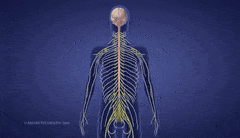The Central Nervous System
The central nervous system consists of the brain and spinal cord, the primary organs of the nervous system. It is responsible for a variety of functions including: conscious experiences, regulation of homeostasis, coordination of reflexes, and more. Its primary function is to integrate sensory information from the CNS and create a response.


Layers of the Brain (Meningeal Layers):
There are multiple layers of protection for the brain, these are called the meningeal layers. Underneath the skull, the dura matter provides protection for the brain. It is a thick, tough, and leathery layer. The arachnoid is underneath, and this layer cushions the brain. It gets its name from its spider-web like appearance. Next is the pia matter which wraps tightly around the brain. Its function is to keep the cerebrospinal-fluid from leaking out of the brain.


Gray Matter
Gray matter is regions in the brain with many cell bodies and dendrites.

White Matter
White matter is the regions in the brain with axons. It is white due to being insulated with myelin, a lipid rich substance.
Matter in the Brain

The Spinal Cord
The spinal cord is the other major component of the central nervous system with the brain. It can be defined as a two way signal system between the brain and body, extending from the brainstem to the lower back. The spinal cord is made out of bundles of nerve cells and fibers wrapped tightly together, with vertebral disks for protein. The cord can be divided into three regions, each responsible for a group of functions. The cervical spinal cord, the most superior region, is responsible for functions of the neck and arm. The thoracic region controls breathing, coughing, and other chest functions. And the most inferior region, the lumbosacral region, is in charge of leg, pelvic, bowel, and bladder functions. The spinothalamic tracts, located in the middle of the spinal cord, carry sensations of pain and temperature to the brain. The dorsal column of the spine carries sensations of position and touch. Carrying out all other bodily functions, the sympathetic and parasympathetic nerves in the spinal cord conduct functions such as heartbeat, breathing, salvation, and more.
Parts of the Brain: Forebrain
Corpus Callosum

A divider that separates the left and right hemispheres, providing a pathway for communication between the two sides.
Cerebral cortex

The “fabric” cover over the brain. Includes gyri which are the ridges of the wrinkled cover and sulci, which are the grooves between gyri.
Frontal Lobe

Lobe involved in personality, behavior, emotion, planning, problem solving, judgement, speech, movement voluntary, self awareness, intelligence, and concentration. Includes broca’s area which is responsible for moving the mouth to produce words.
Parietal Lobe

Lobe involved in language, senses, and interpreting senses. Includes the somatic sensory area which interprets input from sensory receptors and helps with spatial orientation.
Temporal Lobe

Lobe involved in language, memory, hearing, organization, and pattern recognition. Includes Wernicke’s area which is responsible for understanding speech. Also includes the olfactory area which on the ride side is responsible for visual memory, and on the left side is responsible for verbal memory and auditory processing.
Diencephalon

The connection between cerebrum and the rest of the nervous system except for olfaction (smell).
Hypothalamus

Part of the brain responsible for regulating homeostasis, which is keeping the body’s conditions stable.
Pineal Gland

A small endocrine gland that produces and regulates hormones such as melatonin.
Cerebrum
The largest portion of the brain. Functions involved in: speech, memory, logical & emotional response, consciousness, interpretation of sensation, voluntary movement, problem solving

Occipital lobe

Lobe involved in vision, processes visual info and recognizes it
Thalamus

The relay center of the brain which relays information between the cerebral cortex, the PNS, spinal cord, or the brain stem. Also helps with processing information, i.e deciding what needs attention first.
Limbic System

The group of brain structures responsible for motivation, emotion, learning, and memory. Includes the hippocampus that is responsible for long term memory, and the amygdala which works with the hippocampus as well as being involved in fear and aggression.
Basal Ganglia

A group of brain structures that control voluntary movements, habits, and emotions. Located underneath the cerebral cortex but on top of the brain stem, it is the intermediary between our higher thoughts, sensations, and reflexes
Pituitary Gland

A gland that produces hormones and helps relay signals from the hypothalamus to the glands in the body. It is involved in regulation of stress, growth, and reproduction.
Parts of the Brain: Midbrain

Involved in motor movement, auditory and visual functions.
Parts of the Brain: Hindbrain
Pons

A thick bundle of white matter in the hindbrain. It functions to connect the cerebellum and the brainstem.
Cranial Nerves

A group of twelve nerves that control the muscles in the neck and head.
Cerebellum

Functions to perfect motor skills and help form muscle memory of learned motor skills.
Medulla

The medulla is responsible for processing cranial nerve information. It also receives sensory input from the forebrain and passes it to the thalamus, controlling things such as sleep and arousal. In the medulla also lies the reticular formation, which helps control sleep and wakefulness.